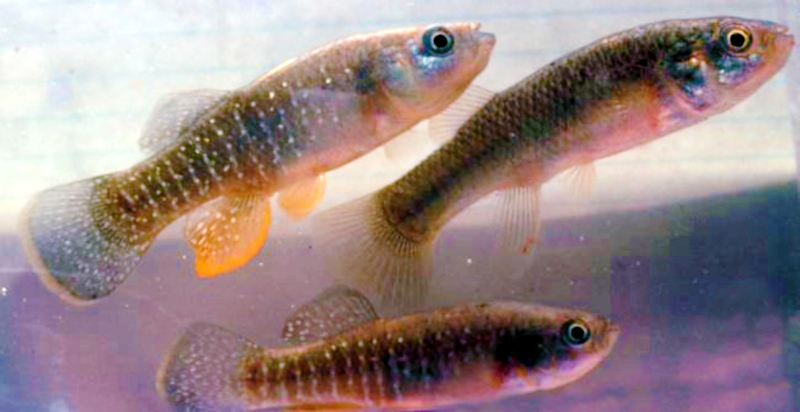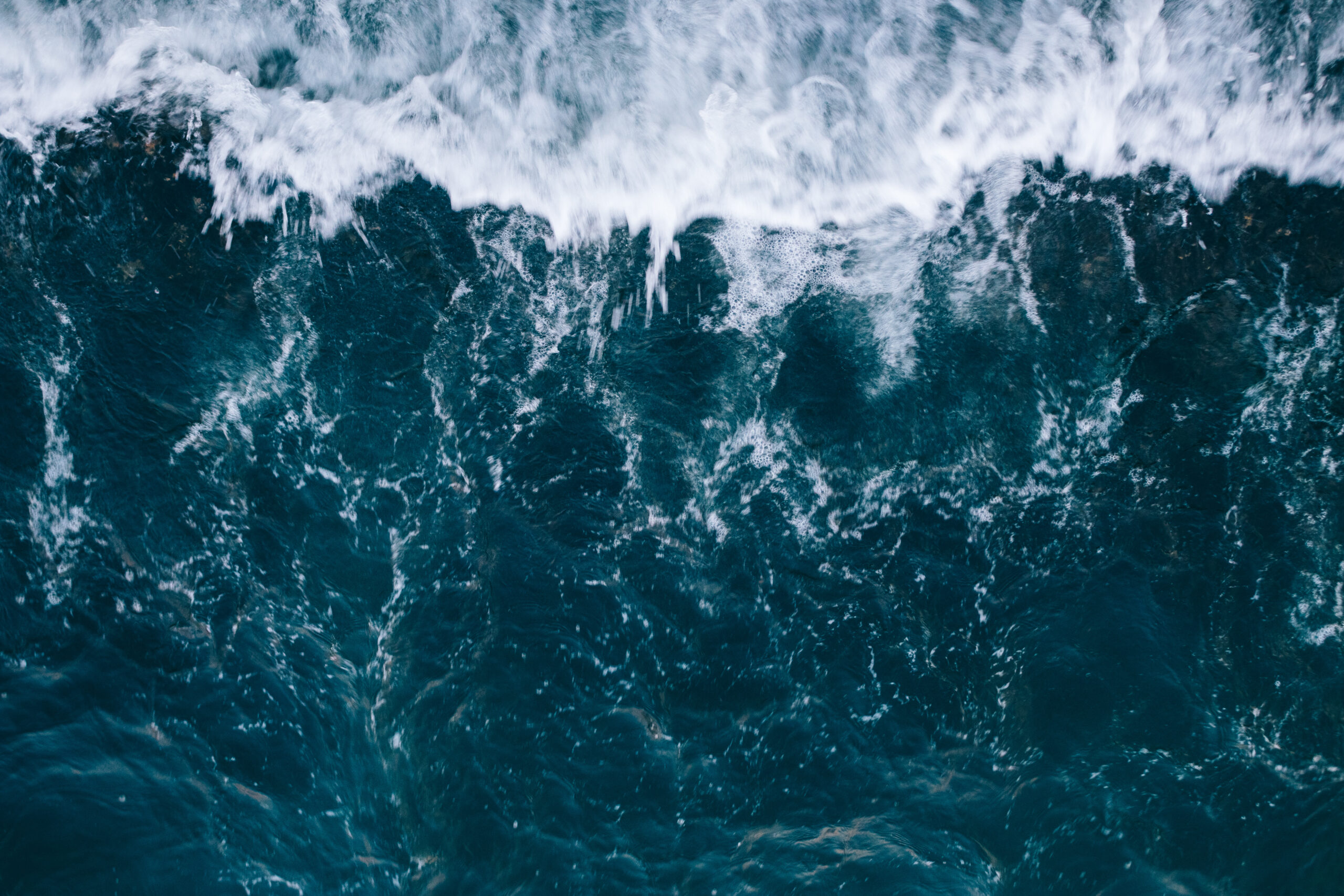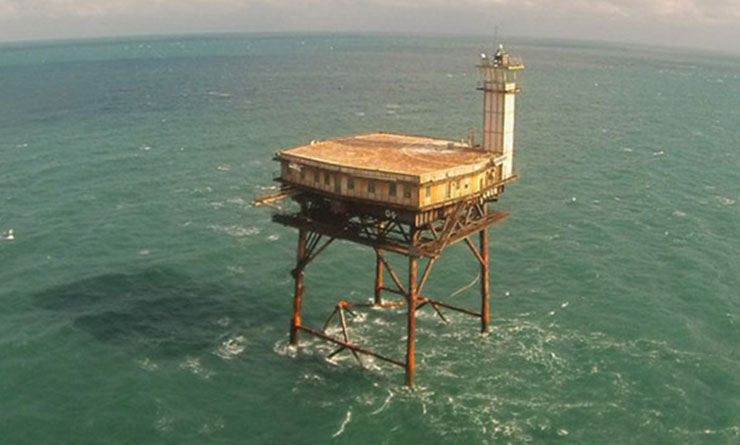Beside a small creek in Beaufort, Paul Rudershausen struggles to unlock a transceiver unit. His effort is a sign that the device has been working well. When the unit was first installed, he said, he might have had to unlock the big metal door several times a day to troubleshoot. Now the lock has become stiff from limited use because all is working as it should.

The transceiver unit looks like a park kiosk. It is informational, with a notice explaining that scientists from North Carolina State University are assessing the population of creek fish. As described, the team will tag fish and place antennas in local creeks to monitor fish movement and “determine population demographics such as growth, age structure, and population size.”
Behind the door of the transceiver unit lies a complex array of high-tech equipment, including a modem that transmits data to Rudershausen’s email, a multiplex antenna receiver, an AC-DC converter and four large batteries.
All this to detect the movement of a small fish.
Called mummichog, Native American for “goes in crowds,” it also is known as a mud minnow, or, up north, as a killifish. The fish frequently is used as live bait to catch many other marine fishes because it is their preferred natural prey.
North Carolina Sea Grant is funding NC State fisheries biologists Jeff Buckel and Joe Hightower, who are Rudershausen’s graduate advisors, to determine if the small fish can act as sentinels for the health of tidal creeks. Buckel is at the Center for Marine Sciences and Technology in Morehead City. Hightower is with the U.S. Geological Survey and the N.C. Cooperative Fish and Wildlife Research Unit at NC State in Raleigh.
Mummichogs, or Fundulus can be found in tidal creeks from Quebec to Texas. According to Rudershausen, in the U.S. Southeast they do best in creeks surrounded by Spartina alterniflora, or smooth cordgrass. As the tide rises, the Spartina grass is flooded. The mummichogs follow the tide onto the flooded marsh.
Altered Areas

Rudershausen installed antenna units in three locations in Morehead City — Pelletier, Porters and Spooner creeks — and an unnamed creek in Beaufort he calls AV Creek. The creeks are found in areas with different “alteration scores” as calculated by the N.C. Coastal Habitat Protection Plan, or CHPP, committee.
Generally, high alteration scores are associated with more development. Jen Weaver, a former Sea Grant/N.C. Division of Marine Fisheries fellow, worked with DMF and Buckel to recommend alteration scores. (See Summer 2012 Coastwatch for a story on CHPP.)
Rudershausen, Buckel and Hightower are testing whether the health of the primary fish species living in the tidal creeks is related to the alteration scores, and thus to coastal development.
Gloria Putnam, Sea Grant coastal resources and communities specialist, agrees with the approach. “A lot of what we look at now is related to bacterial counts and whether the water is safe for human contact and consuming oysters. But we don’t have a lot of biological indicators to assess creek health.” Putnam continues, “I think that’s something we need to look at and focus on more, so we can really tell how these creeks are altered.”
Mummichogs are an ideal type of fish for this study because they tend to stay in or near the location where they are spawned. Thus, the team theorized that mummichogs would be good barometers for the health of the creeks.
As Buckel recounts it, the original grant proposal called for studying two creeks, but the energetic Rudershausen expanded the study to four creeks with antennas, plus two more creeks where he is monitoring the mummichog population.
They are measuring physical parameters of the fish’s growth and movements, as well as biochemical metrics of fish health.
Electronic Data
Buckel and Hightower previously led Sea Grant-funded projects to monitor red drum and spot populations using tagging methods. However, mummichogs need an exceptionally small tag because of their size — they are about 2 inches long.
The tags are radio-frequency tags known as Passive Integrated Transponder, or PIT, tags. The PIT tags are the same as those used for microchipping dogs and cats.
The transceiver detects the electrical current that is produced when the magnetic chip in the tags is close to the antenna wire. Enclosed in PVC pipe, the wire is anchored in the creek and connected to the transceiver unit.
Detecting small tags in marine waters is difficult because salt water masks electrical currents, Rudershausen explains. In tidal creeks it is doubly difficult because salinity varies with rainfall. A downpour can reduce the salinity of the creek. Fortunately, the reader automatically adjusts for the salinity changes.
Rudershausen and Buckel credit Ben Letcher, Matt O’Donnell and Todd Dubreuil at the S.O. Conte Anadromous Fish Research Center in Turners Falls, Mass., for helping them to customize the system for salt water. That group continues to collaborate with the NC State team on improvements in antenna design and ways to analyze the data. The center, named for the late U.S. congressman Silvio O. Conte, was established by the USGS, and is affiliated with the University of Massachusetts Amherst campus.
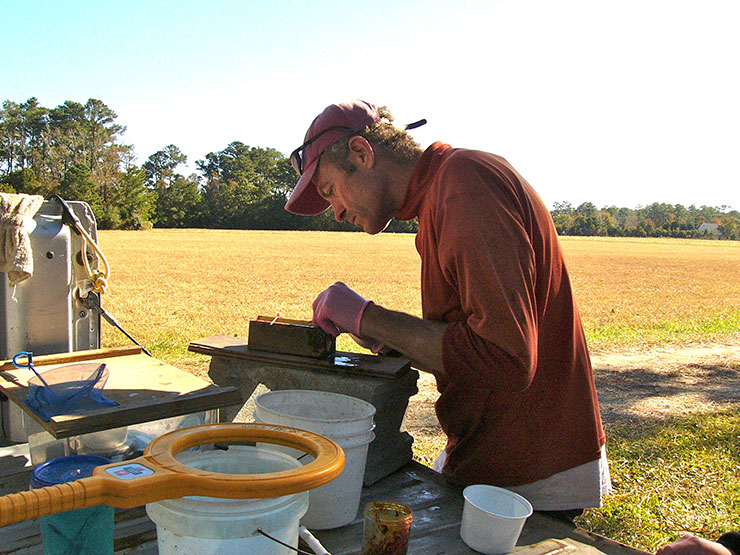
Several times a year, Rudershausen surgically implants upwards of 100 fish per creek with PIT tags, each coded with a unique combination of 13 numbers and letters. When the tagged fish passes near the antenna wire, it is logged as a detection event.
To insert the tag into a mummichog, Rudershausen uses a sterile scalpel to make a small slit in the anesthetized fish’s belly and slides the tag in. Afterwards he applies an iodine mixture and returns the fish to a recovery tank. No suturing is required. In about 10 minutes or less, the fish is swimming about again. He has never lost a fish from the procedure, developed in collaboration with Craig Harms of NC State’s College of Veterinary Medicine.
Once per month, Rudershausen captures mummichogs using minnow traps baited with dry cat food. He measures each fish’s weight, length and sex and checks how many of the captures are tagged. These data allow him to calculate how many fish are in each creek.
Going with the Flow
In an earlier Sea Grant-funded study, Rudershausen installed three antennas in Porters Creek, located in a rural area outside of the Morehead City limits off the Newport River.
He found that he could follow the movements of individual fish in the creek. He initially tagged 44 fish and recorded 1,112 moves past the antennas over four months.
A total of 42 of the 44 tagged fish were detected at some point between November 2010 and August 2011, indicating a high detection rate. But by the end of the study, the apparent survival was only 3 percent, which verifies other studies indicating that the fish are naturally short lived.
They also are prey for birds, crabs and other fish. Rudershausen recounts a winter day when he saw a cormorant scooping up mummichogs. He also has seen blue crab and bluefish having mummichogs for a meal.
The three antennas showed that mummichogs move predominantly in the direction of the tide. They move upstream into the creek headwaters during flood tide and leave the creek headwaters to return to the mouth of the creek, where it drains into the Newport River, late in ebb tide.
Buckel explains that the original function of the antennas was to monitor any fish emigration from the creek, which they assumed would be rare. Instead the team found that the fish were regularly moving out of, and then back into, the marsh creek.
“It was really beautiful data. Every day as the water started to recede, we’d see antennas 3, 2 and 1 register the fish as they moved out of the creek and as soon as the water started to come back in we’d see 1, 2, 3 as the fish came back in. We learned they were moving in and out with the tide and our original supposition that the bulk of these animals would stay in the creek above the antennas was incorrect,” Buckel recalls.
The movements into the creek maximize the fish’s access to the intertidal marsh, which is flooded for about three hours, twice per day in Porters Creek.
At high tides, when the marsh is flooded, mummichogs enter into the Spartina grass to feed and find refuge. A study conducted near Beaufort in the 1980s by National Oceanic and Atmospheric Administration Fisheries researcher William F. Hettler Jr., at the NOAA Beaufort Laboratory, used nets to capture fish during high tide in the marsh. Mummichogs were the most prevalent species.
A Sea Grant-funded study from the 1970s by R.T Kneib and S.E. Stiven of the University of North Carolina at Chapel Hill, showed that mummichogs feed on small crustaceans, insects, algae, fecal pellets and detritus in the marsh grass. Because mummichogs are prey for larger fish such as red drum, they are an important part of the transfer of energy from the marsh to deeper-water fish species.
Back in the Lab
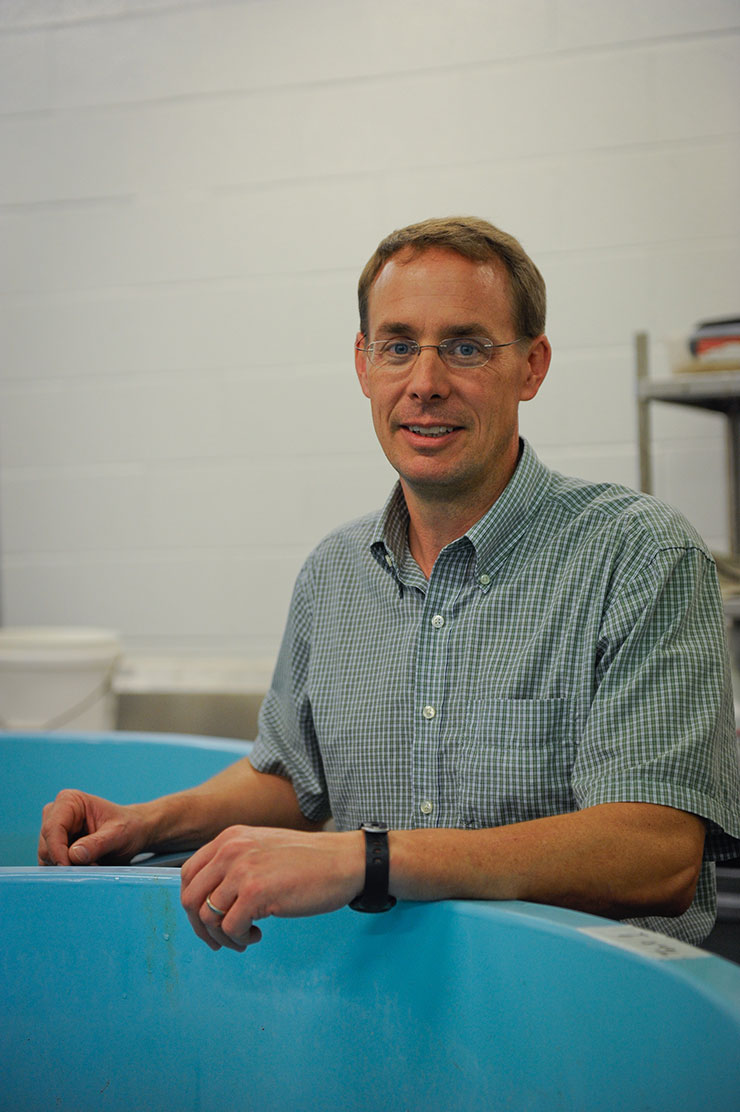
Rudershausen and Buckel are collaborating with NC State toxicologist, Pat McClellen-Green at CMAST, to conduct biochemical measures of fish health. Rudershausen captures and sacrifices untagged fish, measures their length, weight and sex, and then dissects their livers and gonads. He weighs the organs to get a measure of the fish’s metabolic and reproductive health.
McClellen-Green is examining the amount of an indicator protein, CYP1A, that is typically expressed when fish are exposed to contaminants such as polycyclic aromatic hydrocarbons, dioxins, PCBs and many pesticides.
Some polycyclic aromatic hydrocarbons, or PAHs, are toxic to aquatic animals. A recent N.C. Cooperative Extension bulletin detailed the sources as motor oil, tire particles, vehicle exhaust, crumbling asphalt and parking lot sealants. All are components of urban land use. The CHPP committee identified developed land as a significant contributor to alteration of coastal creeks.
Therefore, the creeks in more developed areas or near marinas, such as Pelletier Creek, would have higher alteration scores and also would be expected to contain more PAH contaminants.
In preliminary work, McClellen-Green found that most of the creeks with higher alteration scores also produced fish with more indicator protein. The fish from creeks in developed areas also had larger livers than those from the undeveloped creeks, raising the possibility that livers increased in size in response to contaminants.
McClellen-Green tells of a study in Elizabeth River in Virginia where mummichogs live downstream of a former creosote plant. Creosote, a black tar-like substance used as a wood preservative, leaches PAHs. Most of the Elizabeth River mummichogs downstream of the plant “have massive liver tumors, but they live a normal lifespan,” McClellen-Green says. These fish have become adapted to the high chemical levels. She says changes have occurred in the fish’s genetics. McClellen-Green also will measure biochemical indicators of fish reproduction in both males and females.
Ephemeral Water
Fred Holland, retired director of the Hollings Marine Laboratory run by NOAA in Charleston, S.C., coauthored a booklet with Denise Sanger, now with the S.C. Department of Natural Resources, titled Tidal Creek Habitats, Sentinels of Coastal Health, published by the South Carolina Sea Grant Consortium.
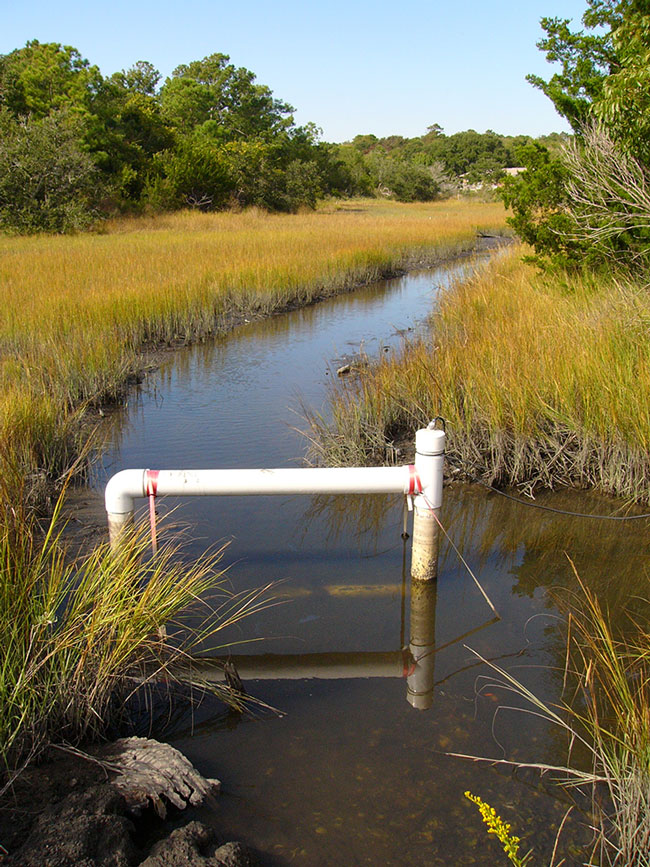
Tidal creeks, as their name implies, rise and fall with the tide. At the 2011 Southeast Tidal Creek Summit organized by Sea Grant programs in North Carolina, South Carolina and Georgia, Holland reported that small tidal creeks drain almost completely at low tide while only about 25 percent of the water drains from the largest tidal creeks at low tide.
Rudershausen is working with smaller creeks. Holland and Sanger’s booklet title is apt. A healthy tidal creek indicates a healthy coastal area.
Sea Grant researcher Martin Posey at the University of North Carolina Wilmington presented research at the summit on the health of oyster populations in New Hanover County tidal creeks. He noted that healthy tidal creeks are nursery habitat for shrimp, blue crab, and many commercially important fish species such as spot, croaker, flounder, menhaden and drum.
Crab, oysters, pinfish and mummichogs are common adult residents of the creeks, Posey adds. Wading birds frequent the creeks also.
Holland and Sanger’s publication calls the headwaters of tidal creeks “first responders to stormwater runoff and are an important habitat for evaluating the impacts of coastal development on aquatic ecosystems.” Their stressors include nearby impervious surfaces, where stormwater drains unimpeded into the creeks.
Although Holland is retired, he remains active in supporting tidal creek research. “If tidal creeks are in good condition, we can expect them to support bountiful seafood supplies that are safe to eat. If our creeks are impaired, it will not be safe to swim in them or eat the seafood they produce,” Holland stresses. “The condition of southeastern tidal creeks tells us if we have managed our landscape in a sustainable manner.”
Rudershausen is still gathering data to study potential differences in mummichog density or growth rates that he can correlate to the health of tidal creeks. But his anecdotal evidence indicates that something is going on in AV Creek in Beaufort. The creek flows through a dilapidated under-road pipe.
“A couple of locals have told me, ‘When I was a kid, there used to be red drum in this creek.’ But something has changed. Probably the period of inundation of the marsh upstream of the road here was longer, so larger organisms like red drum could utilize this marsh system.”
Barbara Doll, water quality specialist at Sea Grant weighs in. “Incorrectly sized or poorly configured culverts can impede water flow and restrict passage of aquatic organisms. Reduced flow can result in upstream sedimentation that buries benthic habitat as well.”
Narrow culverts, developed land use, marinas and other factors considered by the CHPP committee may affect the health of the ecosystem, including the creeks and mummichogs.
Holland is looking forward to the results of the team’s work. “If they successfully demonstrate that the condition of the mummichog population is related to the ecological state of tidal creeks, their research will represent an important contribution to the growing body of science suggesting that tidal creeks are indicators of the health and sustainability of coastal ecosystems.”
Download Tidal Creek Habitats, Sentinels of Coastal Health at www.scseagrant.org/pdf_files/tidal_creeks_booklet.pdf. View documents from the 2011 Southeast Tidal Creeks Summit at www.ncseagrant.org/2011tidalcreekssummit. And read The World of the Saltmarsh by Charles Seabrook.
Clever Fish
On warm nights with a full or new moon, mummichogs can be heard splashing about in the marsh water. Males are in their full nuptial coloration.
Back in the 1970s, researchers from University of Delaware showed that mummichogs spawn in response to the semimonthly tidal cycle.
Reproduction is linked to the highest tides. The tides, known as spring tides, occur throughout the year. (See the Coastwatch Summer 2012 issue for a story on tidal cycles.) Linking reproduction to an outside signal ensures that the males and females are ready to spawn at the same time. Where the eggs are laid along grass stems also is important.
Around the spring tides, the high tide is at its peak and the water level on the Spartina grass in the marsh also is at its highest. During this time of high water, females attach clutches of fertilized eggs to grass stems. The desiccation-resistant eggs then develop at the high-water line, away from underwater predators. Two weeks later, at the next spring tide, the eggs are submerged once again and hatch. The fry grow to adulthood in small marsh pools where they are protected by predation from larger fish.
The California grunion is another fish that famously spawns during spring tides. The grunion ride the spring tide waves to reach as high on the sandy beach as possible where they mate and lay their eggs in the sand. Grunion runs have been featured in music and television.
So far the mummichog is not quite so famous, but maybe that’s about to change.
This article was published in the Winter 2013 issue of Coastwatch.
For contact information and reprint requests, visit ncseagrant.ncsu.edu/coastwatch/contact/.
- Categories:
